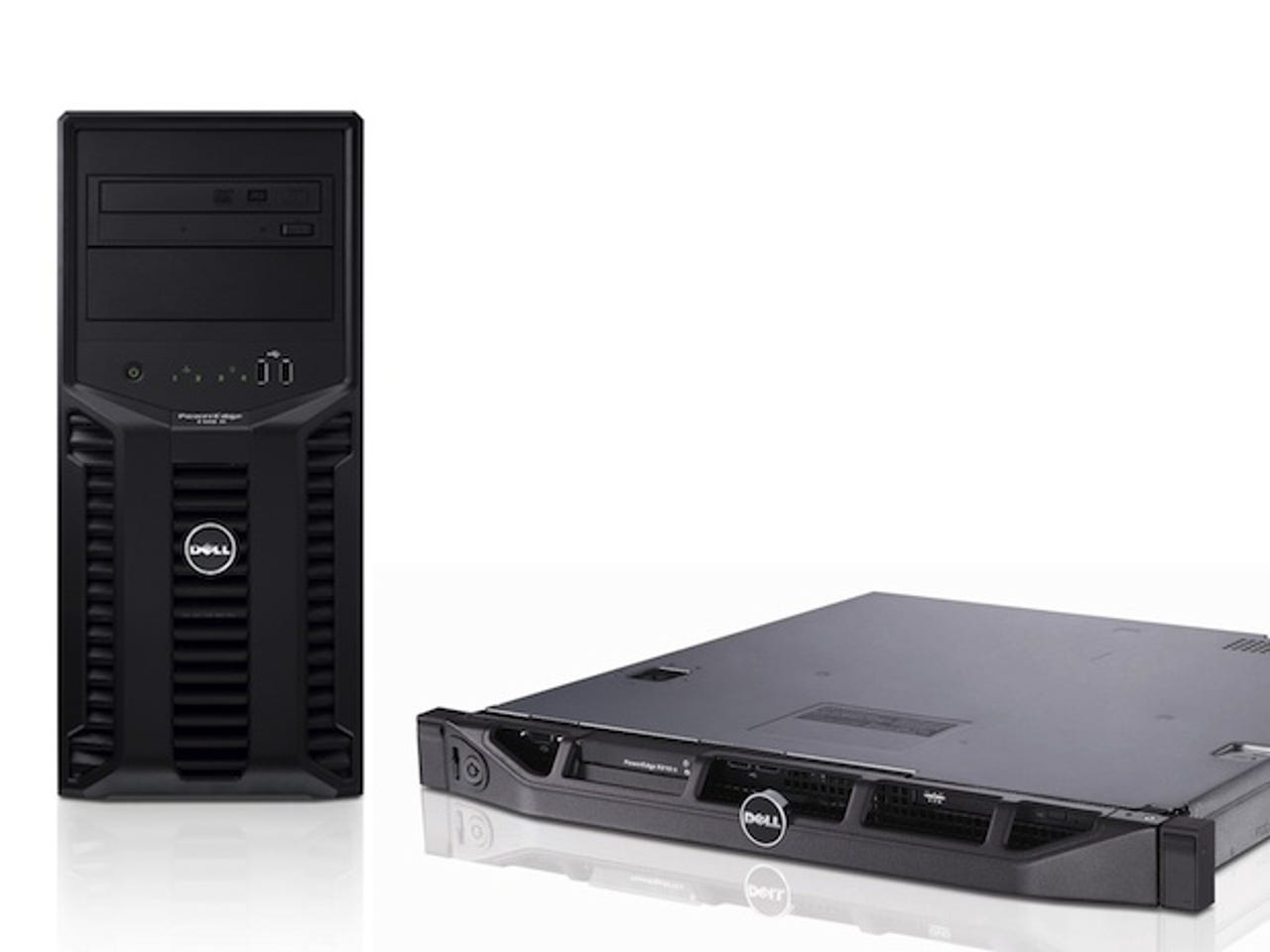Dell PowerEdge T110 II and R210 II

Dell has taken the latest server implementation of Intel's Sandy Bridge architecture — the Xeon E3-1200 series — and used it to refresh its small-business-focussed PowerEdge server line. Specifically, it has launched two all-new products — one in a tower casing (the T110 II), the other a compact 1U rack server (the R210 II).
Despite the different formats the two servers have a lot in common, with similar motherboards built around an Intel C202 chipset, each with a socket to take a single processor from the Xeon E3-1200 family, plus up to 32GB of DDR3 memory in four DIMM slots.

Dell's tower-format PowerEdge T110 and rack-mount R210 both use a single Intel Xeon E3-1200-family CPU and the C202 chipset
The two servers have similar options when it comes to storage, too — at least on the controller side. Dell's software-based PERC S100 comes as standard, and there are optional plug-in PERC hardware controllers for buyers looking for greater flexibility and support for SAS as well as SATA drives.
Given the basic similarities it's not unreasonable to expect similar levels of performance from this duo, and in our tests there was little to choose between them. In their basic form both can be used for basic file- and print-sharing duties, while with the right options they can be configured to host email, collaboration and web servers and more specialised small business applications. However, they are aimed at different buyers, with the tower very much the budget offering. This quickly becomes clear when you look beyond the headline marketing claims.
The rack-mount R210 II we were sent, for example, had a top-of-the-range Xeon E3-1280 on board, giving it four processing cores, eight threads and a clock speed of 3.5GHz. Choose the tower and the top option is the slightly slower E3-1270 with a 3.4GHz clock speed and an 80W TDP compared to 95W on the E3-1280. Not a huge difference, but worth noting if performance is a high priority.
Of course for a lot of SME applications — file and print sharing, for example — the processor specification will make little difference. So, for those on a budget the dual-core 3.1GHz Core i3-2100 processor can be ordered for both platforms with, on the tower, the dual-core Pentium G600/G800 yet another option — one that can really help to keep the price down.
Inside the PowerEdge T110 (left) and R210 (right)
The RAM specification is the same on the two servers, ours coming with 16GB apiece on four DIMMs. You also get the same video controller, a clutch of USB ports and an eSATA connector for external storage that will prove useful for backup.
On the R210 II, however, there are two Gigabit Ethernet interfaces round at the rear of the chassis, whereas on the T110 II tower there's just one. That said, there's scope to plug in additional network cards with four PCIe slots inside the tower case, while the rack chassis has just one, which was occupied by a PERC H200 RAID card on the server we tested.
The lack of physical space on the 1U R210 II also limits the amount of storage it can accommodate: there are two chassis options, for either a pair of 3.5in. drives or four 2.5in. drives. The T110 II, on the other hand can hold four 3.5in. drives, or six drives if you go for the 2.5in. chassis, giving a lot more choice when it comes to storage and the level of redundancy that can be configured.
The maximum internal storage quoted by Dell is 12TB on the T110 II tower and 6TB on the R210 rack. This should be more than enough for most small businesses; our review servers shipped with modest 250GB 3.5in. SATA disks inside — two on the rack and three in the tower. Both servers had PERC hardware RAID adapters and could, therefore, have been specified with SAS or SSD storage, if preferred. And of course there's always the option of external storage or SAN attachment.
There was no operating system installed on our test servers, so we loaded Windows Server 2008 R2 onto each one. It was here that one of the biggest differences between the two products became apparent — not in performance or functionality, but in terms of remote setup and management.
Unfortunately the only management option on the T110 II is an integrated baseboard controller offering basic IPMI remote management. This is not a huge issue in a small business with just one office, but it meant we had no option but to boot from a Windows Server install disk to get our server up and running, and sit in front of the server to perform this task.
The Integrated Dell Remote Access Controller (iDRAC 6 Enterprise) on the 1U R210 provides a graphical remote console
The R210 II, on the other hand, can be specified with a variety of iDRAC management options which, if you're prepared to pay, include support for Dell's unique Lifecycle Controller and a dedicated network port for remote access. It's not cheap, but can simplify management enormously. The iDRAC 6 Enterprise controller on our test server, for example, equipped us with a graphical remote console and virtual media support to install the Windows Server OS over the LAN — a real boon if you're deploying servers out to remote branch office locations.
Overall we were very impressed with Dell's new entry-level servers. Having spent some time with them it was clear that, despite sharing the same basic processor and memory options, they are, in fact, two quite different platforms.
The T110 II is primarily aimed at the small business with just one office, requiring a general-purpose server where the tower chassis provides scope to start small and add extra storage and other options as needed. The R210 II, by contrast, will appeal more to larger organisations and those with multiple sites to manage. The highly compact 1U chassis is a real plus here, enabling the R210 II to be tucked away into a small wall- or floor-mounted cabinet. The R210 also gives you remote management on a par with Dell's big enterprise servers.
The PowerEdge T110 and R210 are equally good buys at £954 and £1,493 (ex. VAT) respectively as reviewed. However, they're not identical, and it's worth taking the time to understand the differences so you get the best platform for the tasks and type of deployment involved.